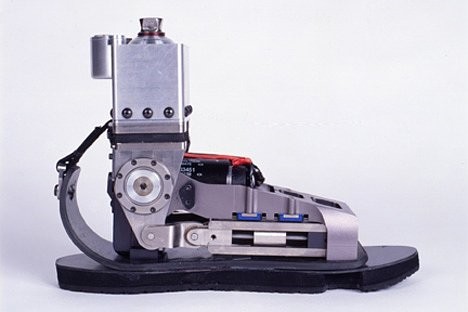The Bionic Foot for amputees


 Engineers at the University of Michigan, Kuo and Steve Collins, have developed a bionic foot prosthesis cutting efforts by 30 % compared to classic prosthesis.
Its principle is based on the recycling of energy between two steps in order to increase its strength. This is the first prosthesis that can capture the unused energy to redistribute it to the foot during the push, and exactly when it needs it, thanks to a microcontroller.
This type of artificial foot is very promising and could be useful for war or natural disaster amputees, such as the many victims of the earthquake of Haiti.
Below is a video in High Definition broadcasted at 6% of normal speed:
http://www.youtube.com/watch?v=KN0qYKCCTdg
Another more conventional prosthesis is the PowerFoot One by iWalk, conceived by Doctor Hugh Herr, a researcher at MIT in Boston.
This robotic foot has an autonomous system with two powerful microprocessors and six environmental sensors that continuously evaluate and adjust (a thousand times per second) the position of the ankle as well as the rigidity, the absorption and the strength of the prosthesis.
Engineers at the University of Michigan, Kuo and Steve Collins, have developed a bionic foot prosthesis cutting efforts by 30 % compared to classic prosthesis.
Its principle is based on the recycling of energy between two steps in order to increase its strength. This is the first prosthesis that can capture the unused energy to redistribute it to the foot during the push, and exactly when it needs it, thanks to a microcontroller.
This type of artificial foot is very promising and could be useful for war or natural disaster amputees, such as the many victims of the earthquake of Haiti.
Below is a video in High Definition broadcasted at 6% of normal speed:
http://www.youtube.com/watch?v=KN0qYKCCTdg
Another more conventional prosthesis is the PowerFoot One by iWalk, conceived by Doctor Hugh Herr, a researcher at MIT in Boston.
This robotic foot has an autonomous system with two powerful microprocessors and six environmental sensors that continuously evaluate and adjust (a thousand times per second) the position of the ankle as well as the rigidity, the absorption and the strength of the prosthesis.
 :
via makezine
:
via makezine
Thanks for helping to keep our community civil!
Notify staff privately
You flagged this as spam. Undo flag.Flag Post
It's Spam
This post is an advertisement, or vandalism. It is not useful or relevant to the current topic.
This post is an advertisement, or vandalism. It is not useful or relevant to the current topic.
You flagged this as spam. Undo flag.Flag Post


